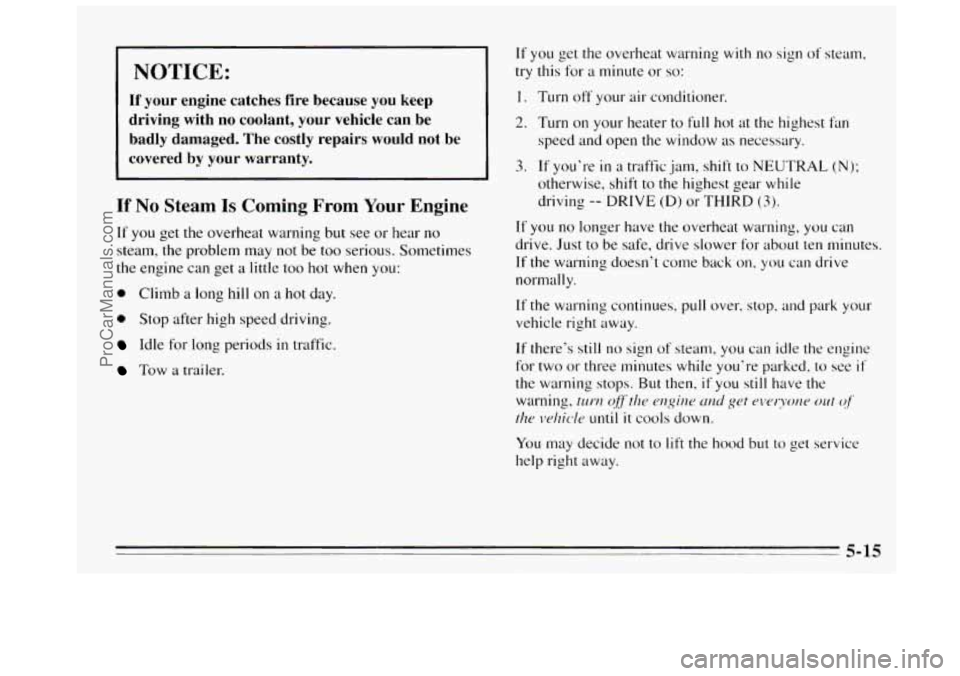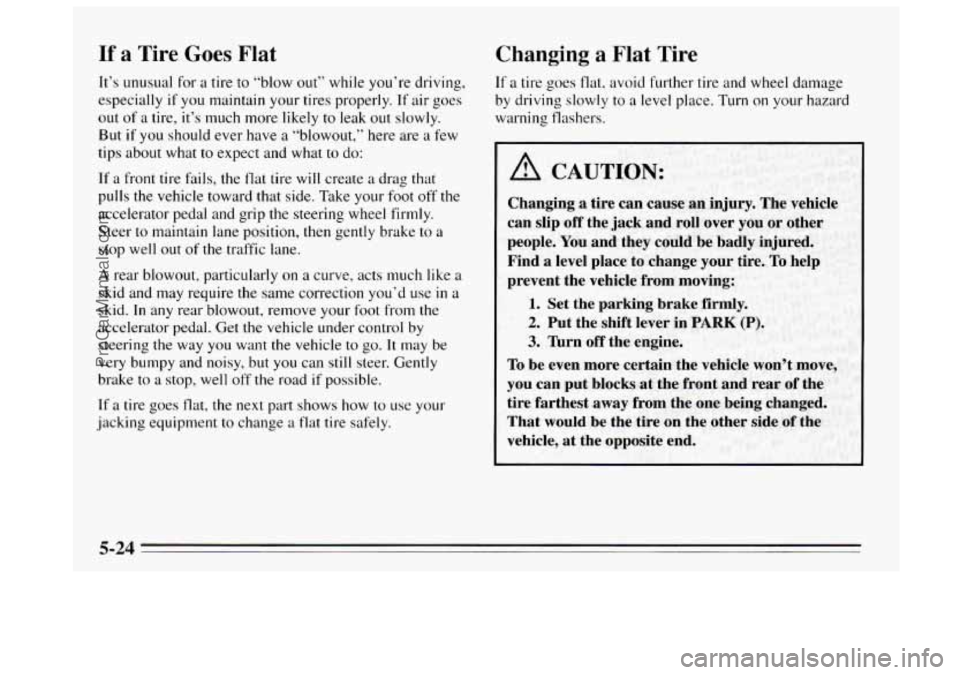Page 183 of 340
When your vehicle is being towed, have the ignition key
off. The steering wheel should be clamped in a
straight-ahead position, with
a clamping device
designed for towing service.
Do not use the vehicle’s
steering column lock for this. The transaxle should be
in
NEUTRAL (N) and the parking brake released.
Don’t have your vehicle towed on the front wheels,
unless
you must. If the vehicle must be towed on the
front wheels, don’t go more than
35 mph (56 km/h) or
farther than
50 miles (80 km) or your transaxle will be
damaged.
If these limits must be exceeded, then the
front wheels have to be supported
on a dolly.
A CAUTION:
5-9
ProCarManuals.com
Page 184 of 340
r ront Towing Hookups
Attach T-hook chains in
front of the wheels into the
side slots
of the cradle on
both sides.
I
Use wheel lift or car carrier equipment. Additional
ramping may be required for car carrier equipment. Use
safety chains and wheel straps.
ProCarManuals.com
Page 185 of 340
NOTICE:
Do not tow with sling-type equipment or
fascia/grille damage will occur.
Towing a vehicle over rough surfaces could
damage a vehicle. Damage can occur from vehicle
to ground
or vehicle to wheel-lift equipment. To
help avoid damage, install a towing dolly and
raise th.e vehicle until adequate clearance
is
obtained between the ground and/or wheel-lift
equipment.
Do not attach winch cables or J-hooks to
suspension components when using car carrier
equipment. Always use
T-hooks inserted in
T-hooks slots. Attach
a separate
safety
chain around the outboard
end
of each lower control
arm.
ProCarManuals.com
Page 186 of 340
Rear Towing Hookups
Att.ach 'T-hook chains into
slots in the bottom of the
floor pan just ahead of the
rear wheels
on both sides.
Use wheel
lift or car carrier equipment. Additional
ramping
may be required for car carrier equipment. Use
safety chains and wheel straps.
ProCarManuals.com
Page 187 of 340
NOTICE:
Do not tow with sling-type equipment or the
rear bumper valance will be damaged.
Towing
a vehicle over rough surfaces could
damage a vehicle. Damage can occur from vehicle
to ground or vehicle to wheel-lift equipment.
To
help avoid damage, install a towing dolly and
raise the vehicle until adequate clearance is
obtained between the ground and/or wheel-lift
equipment.
Do not attach winch cables or J-hooks to
suspension components when using car carrier equipment.
Always use T-hooks inserted in
T-hooks slots. Attach
a separate
safety
chain around the outboard
end of each lower control
arm.
ProCarManuals.com
Page 189 of 340

NOTICE:
If your engine catches fire because you keep
driving with no coolant, your vehicle can be
badly damaged. The costly repairs would not be
covered
by your warranty.
If No Steam Is Coming From Your Engine
If you get the overheat warning but see or hear no
steam, the problem may not be too serious. Sometimes
the engine can get a little too
hot when you:
0 Climb a long hill on a hot day.
0 Stop after high speed driving.
Idle for long periods in traffic.
Tow a trailer.
If you get the overheat warning with no sign of steam,
try this for a minute or so:
1. Turn off your air conditioner
2. Turn on your heater to full hot at the highest fan
speed and open the window as necessary.
3.
If you’re in a traffic jam, shift to NEUTRAL (N);
otherwise, shift to the highest gear while
driving
-- DRIVE (D) or THIRD (3).
If you no longer have the overheat warning, you can
drive. Just to be safe, drive slower for about ten minutes.
If the warning doesn’t come back
on, you can drive
normally.
If the warning continues, pull over, stop, and park your
vehicle right away.
If there’s still
no sign of steam, you can idle the engine
for two
or three minutes while you’re parked, to see if
the warning stops. But then, if you still have the
warning,
rwrl ojftlw engine ~-rnd get owryotw out of’
the vehicle until it cools down.
You may decide not to lift the hood but
help right away. to
get service
5-15
ProCarManuals.com
Page 198 of 340

If a Tire Goes Flat
It’s unusual for a tire to “blow out” while you’re driving,
especially if you maintain your tires properly. If air goes
out
of a tire, it’s much more likely to leak out slowly.
But
if you should ever have a “blowout,” here are a few
tips about what
to expect and what to do:
If a front tire fails, the flat tire will create a drag that
pulls the vehicle toward that side. Take your foot off the
accelerator pedal and grip
the steering wheel firmly.
Steer to maintain lane position, then gently brake
to a
stop well
out of the traffic lane.
A rear blowout, particularly on a curve, acts much like a
skid and may require the same correction you’d use
in a
skid. In any rear blowout, remove your foot from the
accelerator pedal. Get
the vehicle under control by
steering the way
you want the vehicle to go. It may be
very bumpy and noisy, but
you can still steer. Gently
brake
to a stop, well off the road if possible.
If a tire goes flat, the next part shows how to use your
jacking equipment to change
a flat tire safely.
5-24
ProCarManuals.com
Page 203 of 340
Replace the wheel nuts with
the- rounded end of the nuts
toward the wheel. Tighten
each
nut by hand until the
wheel is held against the
Lower
the vehicle by turning the jack handle
coLmterclockwise. Lower the jack completely.
5-29
ProCarManuals.com